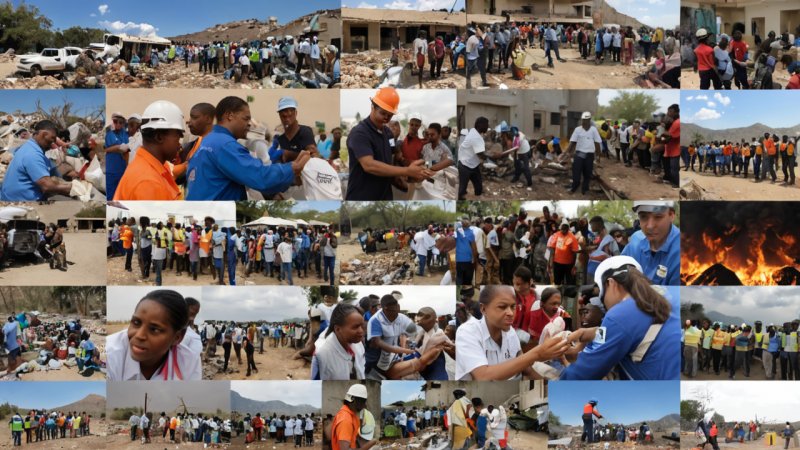In the realm of disaster relief, the effectiveness of response efforts can significantly impact the well-being of affected communities. Two predominant approaches to disaster response are inter-agency coordination and single-agency response. Each method has its strengths and challenges, influencing how quickly and effectively aid reaches those in need. This article will explore these two approaches, highlighting their pros and cons, and examining how they shape disaster relief efforts worldwide.
Understanding Inter-Agency Coordination
Inter-agency coordination refers to the collaborative efforts of multiple organizations, including governments, NGOs, and international agencies, to provide comprehensive disaster relief. This approach aims to streamline resources, share information, and effectively mobilize support in response to crises.
Pros of Inter-Agency Coordination
- Resource Sharing: By pooling resources, agencies can maximize their impact and avoid duplication of efforts.
- Comprehensive Response: A coordinated approach often leads to a more holistic response, addressing various needs from shelter to medical care.
- Expertise Diversification: Different agencies bring unique skills and perspectives, enhancing problem-solving capabilities.
Cons of Inter-Agency Coordination
- Complexity: The involvement of multiple organizations can lead to bureaucratic delays and confusion.
- Communication Challenges: Miscommunication or lack of clarity can hinder effective collaboration.
- Resource Allocation Issues: Disagreements on priorities may lead to inefficient use of resources.
Exploring Single-Agency Response
In contrast, a single-agency response involves one organization taking the lead in disaster relief efforts. This can be a government body or a specific NGO that assumes full responsibility for the response.
Pros of Single-Agency Response
- Streamlined Decision-Making: A singular focus allows for quicker decision-making and implementation.
- Clear Accountability: With one agency in charge, it is easier to track progress and hold the organization accountable.
- Focused Expertise: Specialized agencies can utilize their expertise to address specific aspects of disaster relief effectively.
Cons of Single-Agency Response
- Limited Scope: A single agency may not have the resources or expertise to address all needs comprehensively.
- Potential for Overlap: Without coordination, multiple agencies may respond to the same disaster independently, leading to wasted resources.
- Vulnerability to Criticism: If the agency fails to meet the needs of the community, the entire relief effort may be viewed as inadequate.
Key Differences Between the Two Approaches
While both inter-agency coordination and single-agency response aim to provide relief in times of crisis, their methodologies and outcomes can differ significantly.
Resource Utilization
Inter-agency coordination maximizes resource utilization by sharing assets and expertise, while a single-agency response may rely heavily on its own resources, which can be limiting.
Response Speed
Single-agency responses often result in faster action due to streamlined decision-making, whereas inter-agency coordination may take longer to mobilize but can lead to a more comprehensive response.
Community Engagement
Inter-agency coordination can foster greater community engagement as diverse organizations work together, whereas single-agency responses may lack the same level of stakeholder involvement.
Real-World Examples
To better understand the practical implications of these approaches, let’s look at some real-world examples.
Inter-Agency Coordination: The 2010 Haiti Earthquake
The response to the devastating earthquake in Haiti showcased the effectiveness of inter-agency coordination. Various organizations, including the UN, Red Cross, and numerous NGOs, collaborated to address the overwhelming needs of the population. This collective effort allowed for a more comprehensive response, although it was not without its challenges, such as logistical hurdles and communication breakdowns.
Single-Agency Response: The 2004 Indian Ocean Tsunami
In contrast, the initial response to the Indian Ocean Tsunami saw several countries and organizations acting independently. While some agencies mobilized quickly, the lack of coordination led to overlapping efforts and gaps in services. As a result, the response was criticized for its inefficiency and inability to meet the varied needs of affected communities.
Conclusion
Both inter-agency coordination and single-agency response have their merits and drawbacks in disaster relief efforts. Inter-agency coordination allows for a more comprehensive approach, pooling resources and expertise, while single-agency responses can act swiftly and efficiently. Ultimately, the choice between these approaches may depend on the specific context of the disaster, the nature of the affected community, and the available resources. As humanitarian aid evolves, understanding the strengths and limitations of these methodologies will be essential in crafting effective responses that genuinely meet the needs of those affected by disasters.






